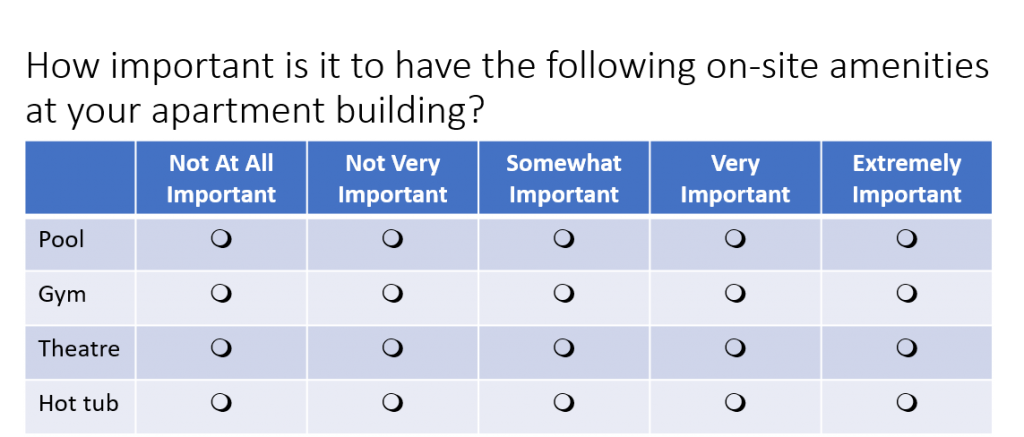A Step-by-Step Guide to Creating Resident Satisfaction Surveys

November 2, 2019
9 min read
When property managers think about resident surveys, often their first step is to hunker down in their office and hammer out a list of questions to ask residents why they stay or move out. But writing a survey is the last step. To find out how your residents really feel about where they live, you first need to ask yourself about why you’re doing a survey in the first place and what you’ll do with the feedback you receive.
Why conduct resident surveys?
- Satisfaction and loyalty
- Engagement
- Product and service enhancements
- Benchmarking for long-term development
Here’s a step-by-step guide to creating resident satisfaction surveys.
Identify the objectives for your resident survey
The first step in conducting a resident survey is to identify your objectives and what you want to learn. Ask yourself:
- Why are you conducting a survey? For example, if one building has a higher turnover compared to other properties in your portfolio, your objective in conducting the resident survey is to find out what’s behind the high churn.
- How will you use this information? When you’ve analyzed the results of your survey, will you share it with your team to improve your services? With decision-makers to fund capital improvements? With prospective residents to help market the property?
- What will you do differently based on feedback? After you conduct your survey about the high turnover rate in the previous example, what would you do if you understood your renter churn?
Once you identify a clear objective — and a plan for what to do with the data once you’ve collected it — you can identify potential ways to gather insights into renter satisfaction.
Identify the best people to answer your resident survey questions
Based on your objectives, who is the most relevant group of “customers” to best answer your questions? Current residents? Former residents? What about prospective residents who applied to any building — what actionable feedback can they provide?
Additionally, how will you identify and reach these customers for your survey: move-out cards? Online surveys? In-person interviews?
The why, what, how and who of your resident survey drives everything. Nail these down before you put pen to paper.
Write your resident survey
Drafting your questionnaire is the hardest part, so don’t work alone. Brainstorm with your team to break down your objectives into individual questions that will capture what you want to know.
Consider doing a few interviews first
If you’re not sure what questions to ask in your survey, consider doing in-person interviews (or simply one-on-one via phone or video chat) first. What do they like and not like about where they live? Make sure your conversation goes beyond rent questions; there’s always more to the conversation than just one aspect.
After a few interviews, you’ll start to see patterns that will help you identify key issues to explore in your resident survey. For example, did you hear feedback about residents wanting more amenities and services, or were their concerns centered around the overall condition of their units and the buildings? Design your survey around what you learned from your qualitative interviews.
Start small
Don’t try to get answers to everything in a single survey. Your objectives (and qualitative interviews, if you did them) should give you a good idea of areas to target. Pick one and write your resident survey around that.
When you’re ready to write your resident survey, break it into four parts for flow.
1. Introduction and warm-up
Thank residents for taking the time to complete your survey. Remind them of any incentives you’re offering for their participation. Give them an idea of how long the survey might take to complete.
Warm them up by asking them to tell you a little about themselves. Easy warm-up questions are noninvasive and easily answered to start building trust; for example, “How long have you lived in your apartment?” or “What’s your favorite way to spend downtime?”
2. Dependent variables
These are the behaviors, perceptions or attitudes you are hoping to change with your resident survey. Using the high turnover example, our hypothesis might be that turnover at X community is high because residents don’t feel acknowledged or appreciated by on-site staff.
Dependent variable: Low resident retention
Dependent variable questions: How would you rate your overall satisfaction with the service X community’s on-site staff provides you? How likely are you to renew your lease?
Those who respond that they are unsatisfied with the service or unlikely to renew signal that satisfaction might be a factor in the residents’ intent to stay or not.
Always ask at least two dependent variable questions (no more than three) in your survey because resident satisfaction is never dictated by a single issue.
 3. Independent variables
3. Independent variables
These are things you think might impact your dependent variables. In the high turnover example…
Independent variable: Poor on-site staff interaction
Independent variable questions: How easy does the on-site staff make it to contact them? How satisfied are you with the on-site staff’s overall speed of response? How satisfied are you with the on-site staff’s ability to resolve your issues? How satisfied are you with the on-site staff’s communication while resolving your issues?
Limit your independent variable questions to 12 or fewer to keep residents engaged with the survey. Using a grid and subsections helps with the flow:
 4. Demographics
4. Demographics
These questions include age, income, gender, marital status, household composition, pets and education. Collecting this information gives you the ability to create targeted messaging and marketing programs that will resonate with your residents. For example, if you find that most of your residents have dogs, you could consider partnering with a grooming service and give residents discounts. Collecting demographic data also helps you segment your audience to create specific programs for different subsets of residents — say, a wine tasting event for single residents of drinking age and an afternoon picnic for parents with children.
Be mindful that demographic information is personal information. Ask yourself, “What would I do with this data?” and only ask questions that help meet your objectives. Make sure your questions do not violate fair housing guidelines, and consider explaining to residents why you’re asking for demographic information: to help you understand residents better so you can best meet their needs. Save resident demographics for the end of your survey, as these questions can be sensitive and therefore risk a resident exiting the survey before completing it.
Consider the right measurement scale
The response scale you choose depends upon how you want to use the data later: Do you want to describe an answer or to quantify one? Each scale has its pros and cons, but the best one to use is the one that residents clearly understand and your researcher easily interprets.
Here are a few different scale types and when to use them:
- Dichotomous. Two-point scales where the options are opposite. Use dichotomous scales when you want residents to commit to only one of two options.
For example: Yes/No, True/False, Agree/Disagree.
- Rating. Offers multiple labeled options that residents can answer neutrally. For the most reliable results, label all the points on a rating scale, not just the first and last endpoints. Use rating scales when you want to give residents the choice of neutrality.
For example: 3-, 5- or 7-point scales. A 5-point scale (recommended) would be labeled as Strongly Agree, Agree, Undecided/Neutral, Disagree and Strongly Disagree.
- Categorical or nominal. Provides single or multiple response options.
For example: Which credit card do you have? Select all that apply.
- Ranking. A list of options that residents sort by dragging and dropping. Use ranking scales to narrow down the importance of each option more precisely than you would using a rating scale.
For example: Rank the following building amenities in order of preference: Pool, gym, theatre, hot tub.
- Text entry. An open-ended question that isn’t a measured response. Never start your survey with a text entry or open-ended question. They make respondents put more energy and focus into their answer. The more cognitive load you put on a respondent, the less reliable their answer is. Use text entry to get a resident’s unrestricted response.
For example: What can we do to improve the touring experience?
Avoid biased survey results
Bias often occurs when the survey sample does not accurately represent the population. Common sources of survey bias include:
- Under-coverage. This is when some members of the population are inadequately represented in the sample. To avoid under-coverage, include all residents in your survey rather than a smaller, random selection.
- Voluntary response. This is when sample members are self-selected volunteers and overrepresent individuals with strong opinions. To avoid voluntary response, include all residents in your survey and not just the squeaky wheels who you feel are most likely to complete your survey.
- Leading questions. This is when the survey question wording favors one response over another. To avoid using leading questions, provide all options to a question or offer “Other” as a choice.
- Double-barreled questions. This is a question that asks two things. For example, “How would you rate the response time and usefulness of on-site staff?” Since there is only one way to answer, you don’t know how to analyze the data. To avoid double-barreled questions, break the query into two: “How would you rate the on-site staff’s response time?” and “How would you rate the on-site staff’s usefulness?”
Begin your resident survey
You’ve got this! Prioritize your efforts and start small: When it comes to resident surveys, the shorter the better. You’ll quickly find out what their top concerns are so you can focus on them going forward.
Free versions of online survey tools such as Qualtrics and SurveyMonkey are easy-to-use sites that can help you generate your survey. To get the best understanding of your residents’ feedback, consider using the paid versions, which don’t have to break the bank.
Whichever tool you use, be sure it includes a way to download and share your results for reporting purposes.
Report your resident survey findings
You should also know how you’re going to analyze and report on the data before you even launch your survey because it’s all based on your objectives. Bringing in a professional to help you with data analysis ensures the information you capture is informative and actionable.
Include these key sections in your reporting:
- Objectives. Remind stakeholders why you conducted the resident survey, what you hoped to find and what they should take away from it. Set up expectations around the intent of the survey and what the next one might include, based on what you discovered.
- Methodology and timing. Share how you documented the process so you can more easily repeat it.
- Key findings and implications (also known as the executive summary). In two pages or fewer, summarize all the data in terms of the actions you’re going to take based on the survey feedback.
- Detailed findings. Include the nitty-gritty details. Consider how you want to show the data based on your objectives and survey findings: a spreadsheet or presentation? Infographics or charts?
When you know how to ask residents the right questions — and effectively use the data they give you — you’ll have a much better idea how to keep your renters satisfied and renewing their leases.
Connect with us!
Learn how Zillow Rentals can help you reach your goals.
Stay informed. Stay ahead.
Access exclusive industry insights, market trends, and expert tips. Subscribe now to receive quarterly Zillow Rentals newsletters!